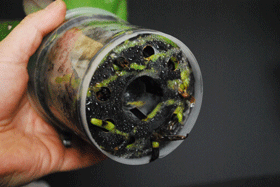 As a rule of thumb, Phalaenopsis orchids must be repotted every year or two. You can tell it is time to repot your orchid when:
As a rule of thumb, Phalaenopsis orchids must be repotted every year or two. You can tell it is time to repot your orchid when:
- The orchid has outgrown its pot and new growth and roots are spilling over the edge of the pot. Because Phalaenopsis orchids are epiphytes (tree-dwellers whose roots grow in the air and not in the ground), it is normal for some roots to loop or grow above the soil and over the pot edge. Repotting is indicated when air roots become excessive.
- The growing medium has broken down and no longer allows the pot to drain properly. Potting material will appear to have lost its chunkiness and may remain damp between waterings or look mushy. If potting medium is not replaced, soggy roots will begin to rot. Replacing spent potting medium with fresh materials will restore proper drainage.
- If your orchid becomes diseased or infested by pests, repotting it in fresh medium is recommended to remove the plant from the problem environment and improve its chances of recovery.
The best time to repot Phalaenopsis orchids is shortly after they have finished blooming. If repotting your orchid into a plastic pot, choose one that allows about 1/2 inch of space around all sides of the root mass. If using a clay pot, increase the space between the root mass and the side of the new pot to 1 inch; slightly more if a clay orchid pot (one with slits in the sides to increase air flow) is being used.
For more information, watch our helpful video on orchid repotting.
 As a rule of thumb, Phalaenopsis orchids must be repotted every year or two. You can tell it is time to repot your orchid when:
As a rule of thumb, Phalaenopsis orchids must be repotted every year or two. You can tell it is time to repot your orchid when: 